The time I turned my back on the Fann Mountains…
“I call them wild mountains,” announced Vadim, our mountain guide who served as special forces in the Russian military with subtle pride. Our group of 6 nodded, distracted from taking photos of the mountains. That statement was stuck in my head the entire seven days of trekking the Fann Mountains.
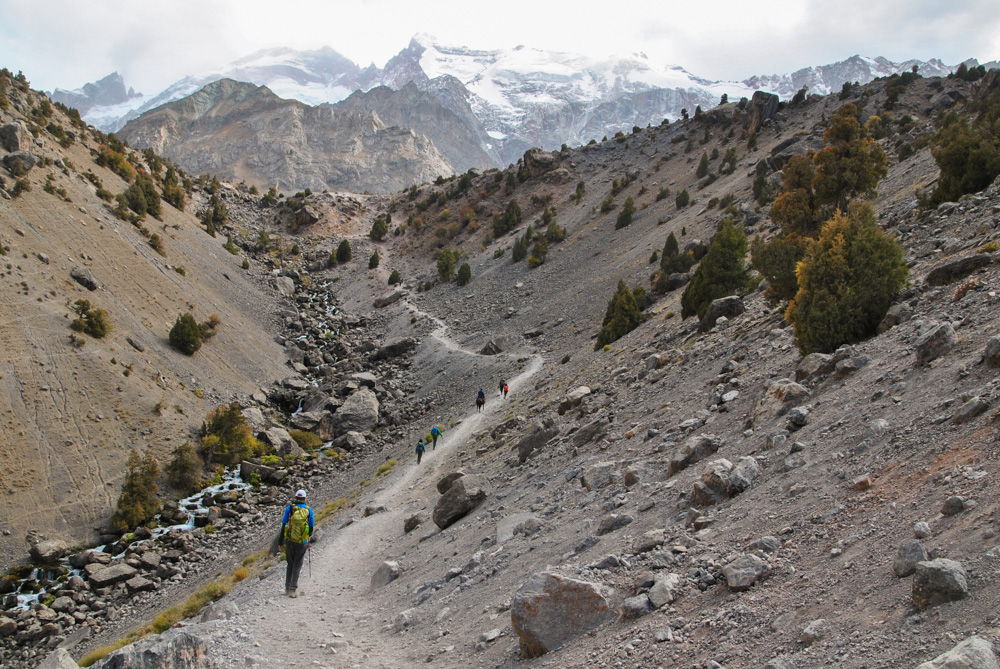
“What exactly is in Tajikistan, and why are we going there?” my husband Mattis had asked, slightly annoyed, just two weeks ago. I waved at him to sit next to me and pointed to my laptop screen.
“This is where we’re going,” I said, scrolling through the website, showing photo after photo of the Fann Mountains.
He took the mouse from me and clicked on the itinerary. “This is a remote trek. It’s going to be cold and difficult. We’re going to be sleeping in tents. We could be trekking in the snow. No showers and proper toilets for ten days. Are you ready for this?”
I pointed to the photos of the mountains and lakes again.
“Ok then, let’s go.” He walked away, knowing his OCD wife had lost her mind.
Fast forward two weeks and here we are, standing at the base of Kulikalon Lake, at 2,880m, one of the many ‘Gems of Tajikistan’ due to their aquamarine and turquoise lakes. The tops of the furthermost ranges capped with shiny white fresh ice.
Wow, I thought. The photos on Google weren’t photoshopped.
Everybody stood at a distance, snapping the panoramic view of the mountains and lakes, and taking selfies. I broke away from the group and walked towards the water.
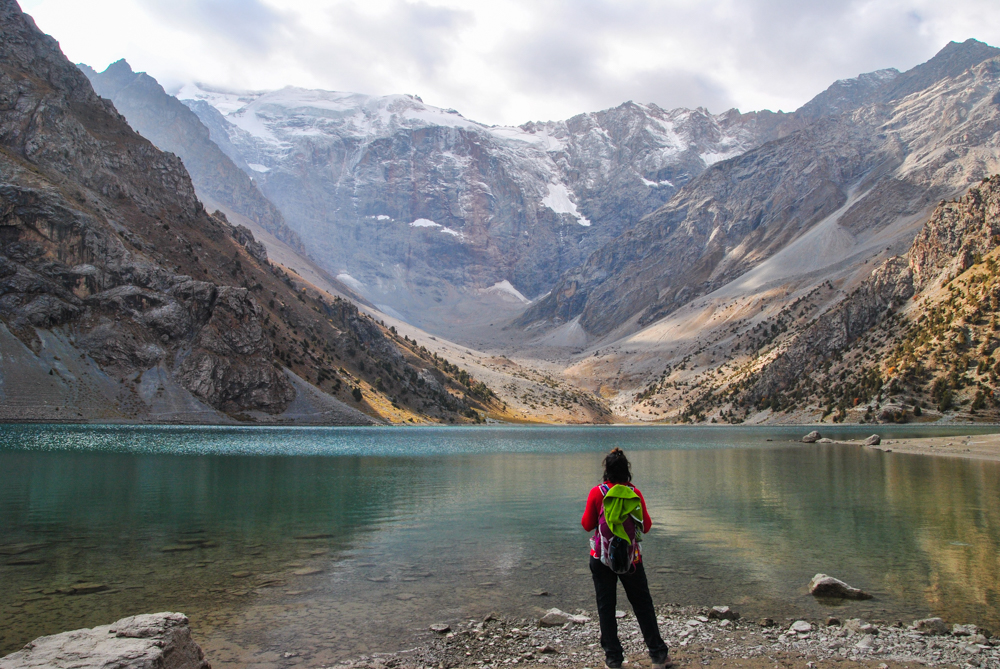
It was silent – no sounds of water lapping against the rocky shorelines and not a ripple in sight. It was pristine. It was transparent and still, like glass. The turquoise water was crystal clear. So crystal that your eyes can see the bottom of the lake. If I tried, I would’ve been able to count every rock and pebble at the bottom of the lake without having to pick them out of the water. I dipped my hands in the water.
I thought, how can a lake, surrounded by juniper forests, placed in the middle of rocky promontories, surrounded by slopes of the Western Fann Range’s close to the shores, can be so untouched, unspoiled and uninhabited?
Locals say the water at Kulikalon Lakes, translated from Tajik as ‘a big lake,’ the second largest lake in the Fann Mountains, is sacred. The lake also can shimmer with all colours of a rainbow. That, I did not see, unfortunately. But what I saw, standing in the middle of it all was a beauty that was wildly unnerving. For some strange reason, I felt slightly anxious.
“Ok, we ready? Raftem!” said Vadim, and he started moving us out towards the western part of the depression and towards the famous Chukurak Pass at 3,180 m.
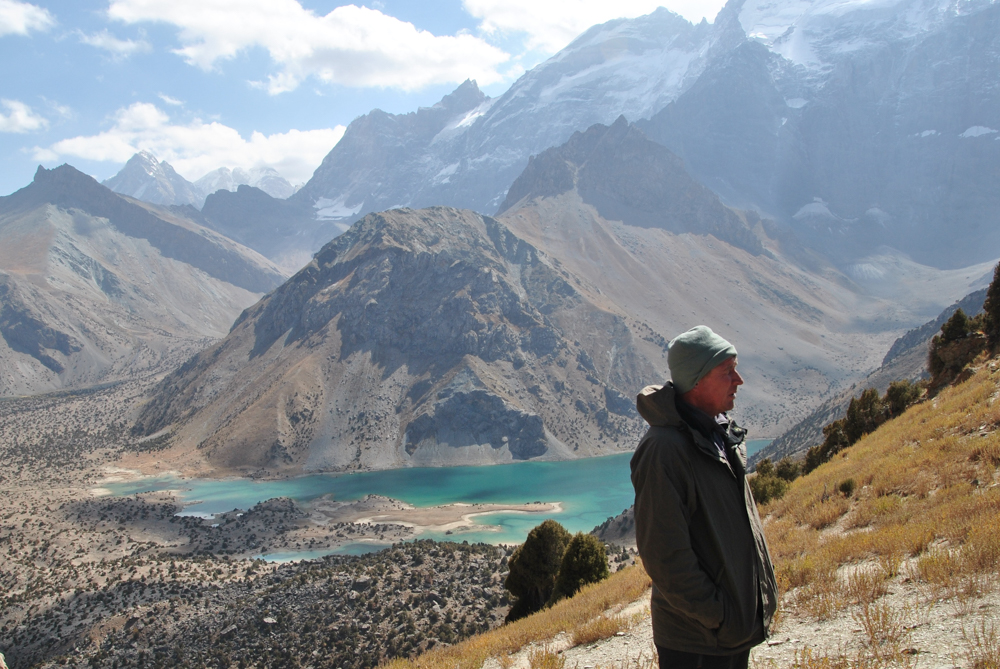
The next day, we left our campsite at Bibi-Jonat Lake, and steadily trudged towards the eastern part of the depression paths where the Alaudin Pass sits at 3,860 m. I do not know if it was my upset tummy or my inadequate fitness level for an uphill climb, but one hour into our ascent, Vadim pulled himself aside and waited until I caught up, last behind the group.
“Excuse me. I think you follow behind me now. We are going very slow, and we will not reach the pass by 12 pm. I think I’m going very slow, yes? You walk behind me, and we don’t stop…body like car. You stop every five minutes, car spoil.”
Slightly red-faced I fell in line behind him as the rest of the group adjusted their positions.
At 12 pm, we were in the saddle of Alaudin pass. As one of the few passes with mobile connectivity, Vadim made two essential calls. The first, to inform Alovaddin, founder of Paramount Journey (our tour operator) that we’ve reached safely. The second, to a trekking buddy to pick up a bottle of vodka for a celebratory dinner once we descended.
As the high, cold wind blew, sitting on the broad and long saddle started to be uncomfortable. But none of us bothered to move. As we sipped our chai and stuffed our faces with Snickers, Mars bars, and nuts, we got beautiful 360-degree views of the surrounding mountains.
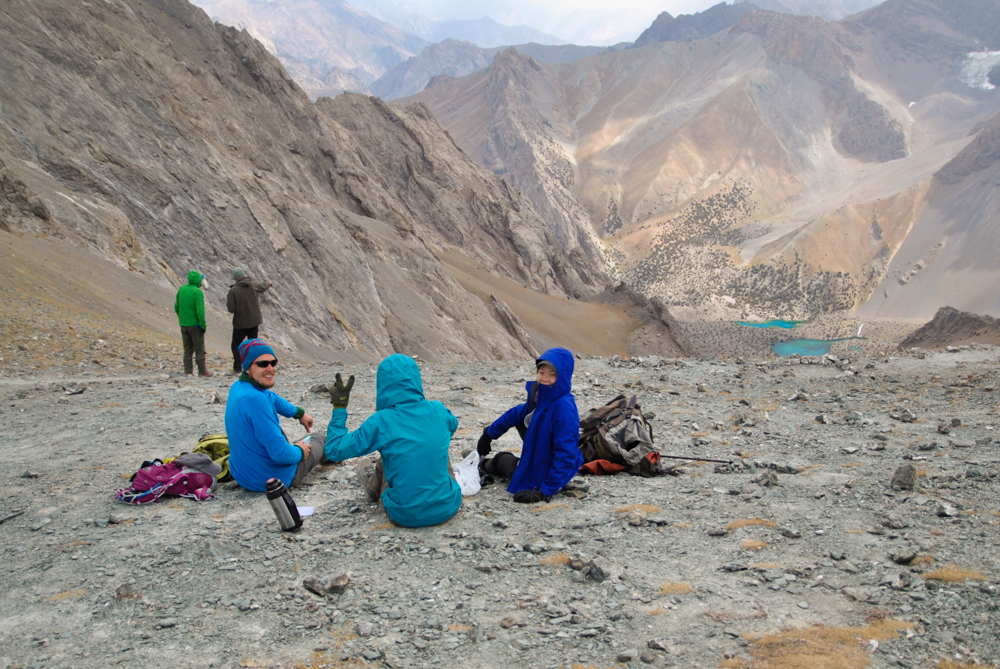
The low hanging clouds clung to the tops of the spiky, icy peaks of Bodkhona (5,138m), Chapdara (5,050m), and Zamok (5,070m). Becuase it was the start of winter, everything looked grey, black, and brown. Instead of green grass and trees dotting the slopes, we had rocks and dirt. However, without the distracting palette of the summer and spring colours, our eyes were drawn to the gems of the Fann Mountains — the ultramarine surface of lakes Alaudin.
As we had three hours of steep and a loose, rocky descent ahead of us, we decided to pack up and move on. Views over the Pasrud Valley (toward the north-east) were mesmerising, distracting. But we were too slow and started half skiing with our walking poles. We finally reached the base and navigated our way through the forests and towards the lake.
The water gave off shades of blue, green, and even hints of purple from various angles. It looked as if the sky and lake met. Every single detail above the water — the shrubs, trees, streams, peaks, valleys, misshapen clouds, and colours — was reflected clearly on the surface. I bent down and touched the crystal-clear, cold-as ice-water. Again, everything was still and quiet. Once again, anxiousness crept in.
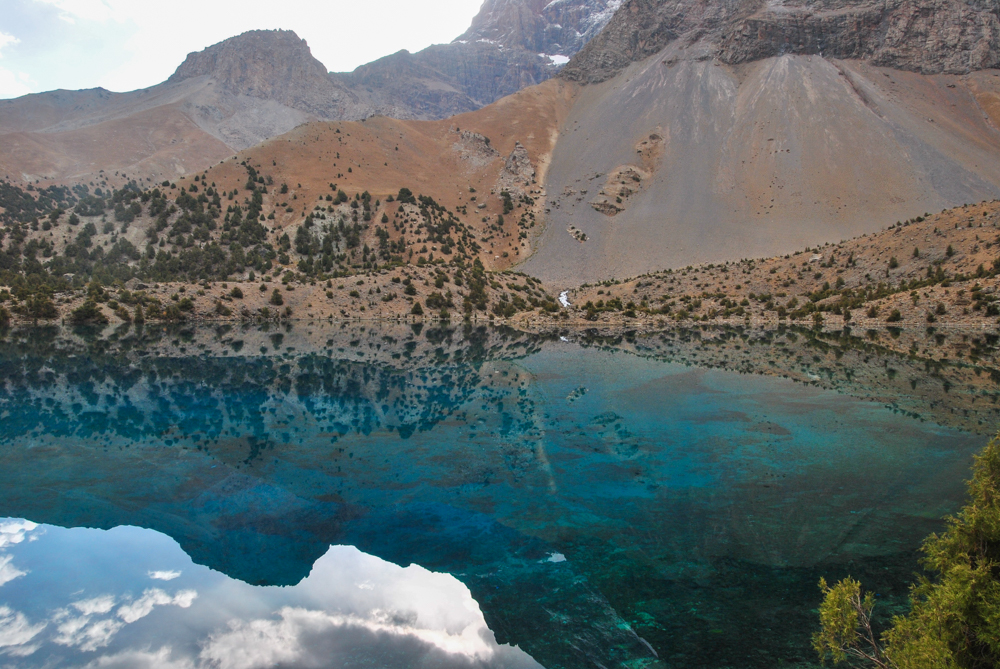
The next day we knew we were getting closer to the highlight of our trek now, crossing Chimtarga pass at 4,750m, which lies between the peaks of Energia (5,120m) and Chimtarga (5,489m). But first, we had to start walking into the heart of the Fann Mountains and lay camp at Mutnye (‘Muddy’) Lake at 3,510m.
After a steep four-hour hike uphill, we reached the top. There, nestled in the rubble-covered valley, was Mutnye Lake. It’s high up, in between the mountains, somehow placed above sea level. What?!
As daylight was slowly disappearing and strong winds had started to pick up, it was a scramble within the group to find a low-lying spot between higher rocks to shield us from the winds and to pitch the tents. We had an early dinner and walked back to our tents, which were slowly now being covered by snow.
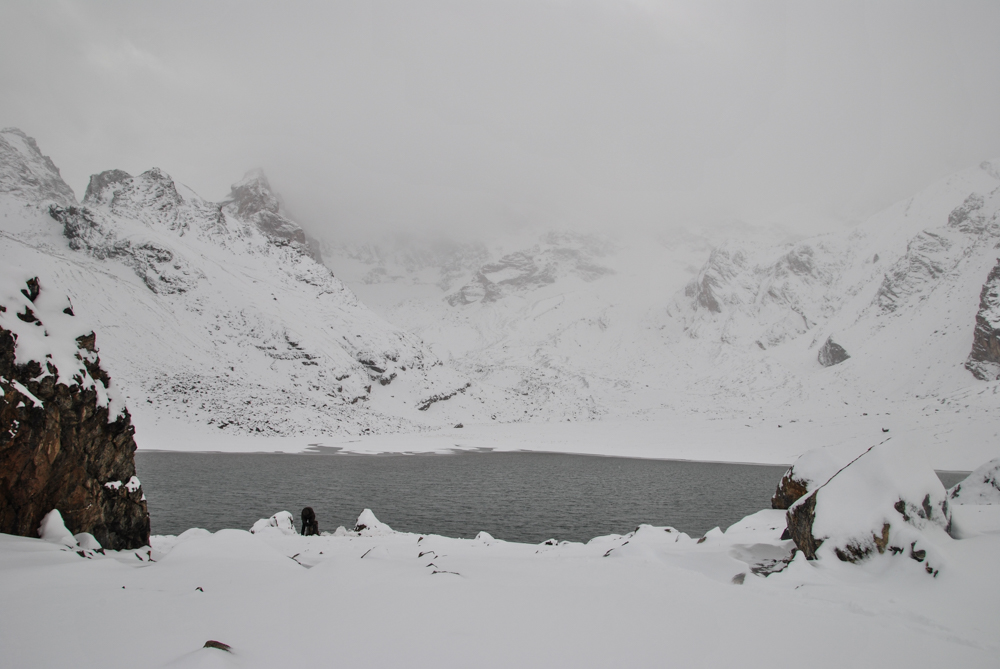
Throughout the night, Mattis and I did not sleep. We were kept awake by loud winds and steady snow raining down on the canvas. At 5.45 am, completely wide awake, we started to get dressed for the trek.
Bang! Bang! “Tuk, Tuk. I help you take out the snow from tent ok?” said Vadim as he hit the sides of the tent. The morning light slowly crept in, and we were able to see through the walls of our tent. Overnight it had snowed hard, and it had almost caved in on us!
“Snow now 15cm. We start later. I will call you again.”
An hour later, with by now 20cm of snow, the group huddled in the main tent. Vadim had called Alovaddin via satellite phone several times to get the updated weather forecast. They were discussing alternatives to either trek over Kaznok pass (4,040m) from Mutnye lake towards Saratog village, or to drive to Iskanderkul Lake for the lower trek to Alexander’s hat peak (3,340m).
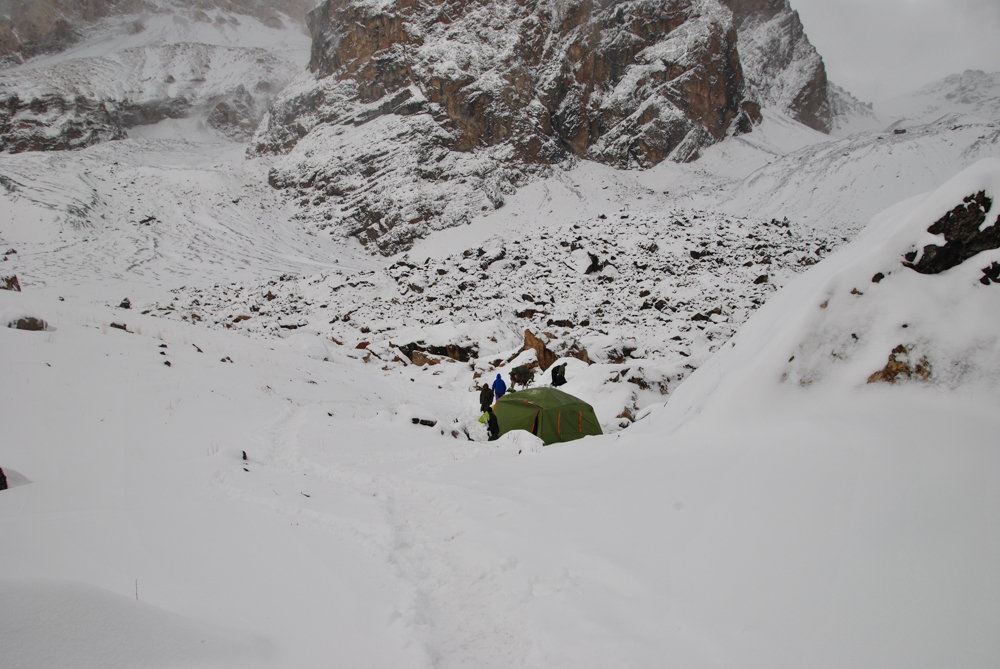
As we fed on breakfast and drank hot chai, Vadim sat down on a box and explained the situation and the call with Alovaddin. “At this time, it shouldn’t be snowing,” he said surprised. “Too dangerous and uncomfortable to stay overnight at the pass. Strong winds and snow.”
“Option two, we go back down Alaudin Lake, camp at old Soviet mountaineering guesthouse and decide to go another trek.”
We stared at him in silence. Not climb Chimtarga Pass? Head down? After days of trekking, and because of the damn snow, we’ve to miss admiring the highest summits in the Fann Mountains – Energia, Zamok, and Chimtarga?!
“A Russian team stuck up in pass now, they can’t come down yet,” Vadim continued.
Deep down we all knew none of us wanted to be stuck at 4,750m overnight in the cold and wind.
We packed up and started heading down the trail wishing we had skis to go down quicker. It was cold and windy, but as we went lower the snow got lesser, melted faster, winds died down, and the avalanches started from a safe distance. That night before dinner we experienced our first mini earthquake.
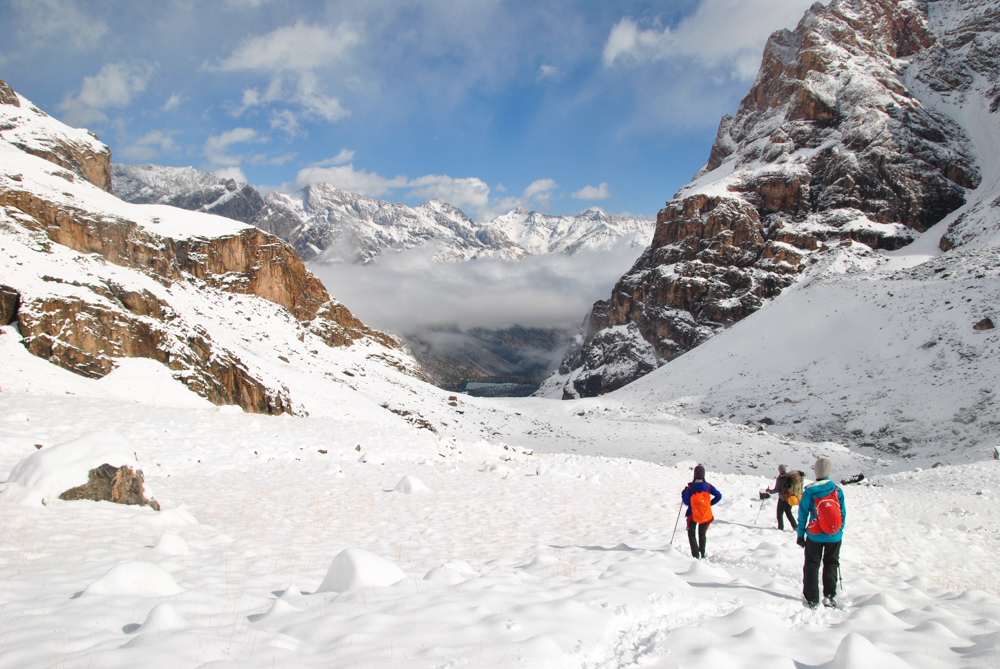
The next day after breakfast, after tipping our porters, cook and donkey handlers, the team parted ways.
Two trekking mates left for the second part of their trip earlier than expected that included a trip to the Pamirs. The remaining three of us will drive to Iskanderkul Lake, the jewel of Pamir-Alay, for the lower trek to Alexander’s hat.
Usually, it takes time to put together two separate trips as it involves arranging visas to the Pamirs, sorting out transports and accommodations. However, thanks to Alovaddin at Paramount Journey’s mad wizard skills, the contingency plans were laid out so quickly, that we all said our goodbyes and drove off in separate vehicles with no time wasted.
On the morning of our trek to Iskanderkul Lake, while navigating through the winding roads, Vadim explained how the lake got its name.
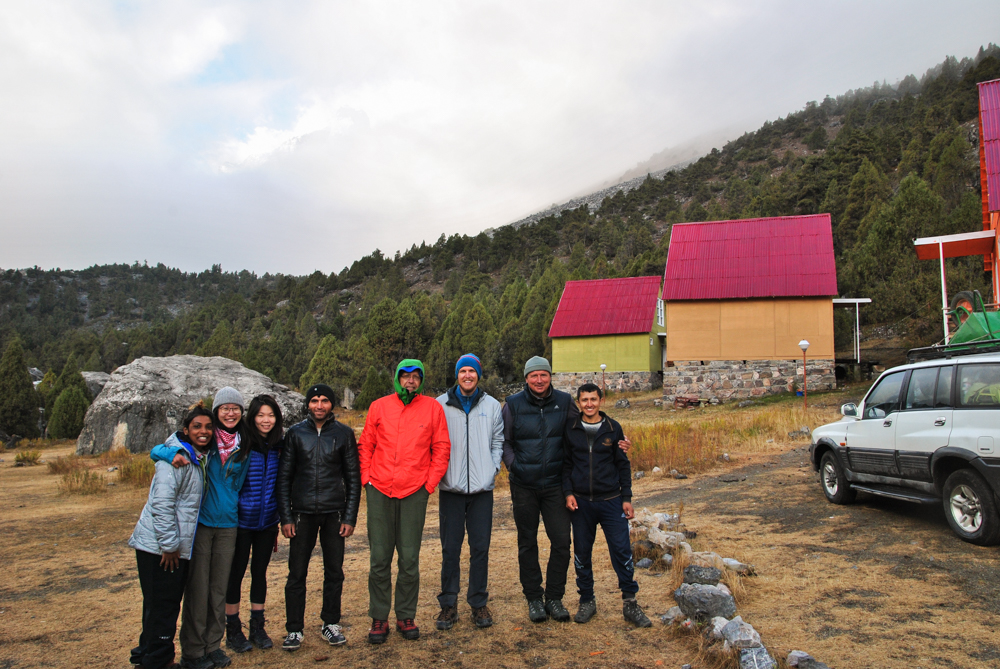
On this morning drive, while navigating the winding roads, Vadim explained how the lake got its name.
The oldest legend started 2300 years ago of a mindless war between the most significant military leader of the ancient world, Alexander The Great and freedom-loving dwellers. The fighting led to the demise of his beloved warhorse, Bucephalus who fell to its death in the lake.
“Locals say, during summer nights Bucephalus comes out of the lake,” he said shrugging his shoulders.
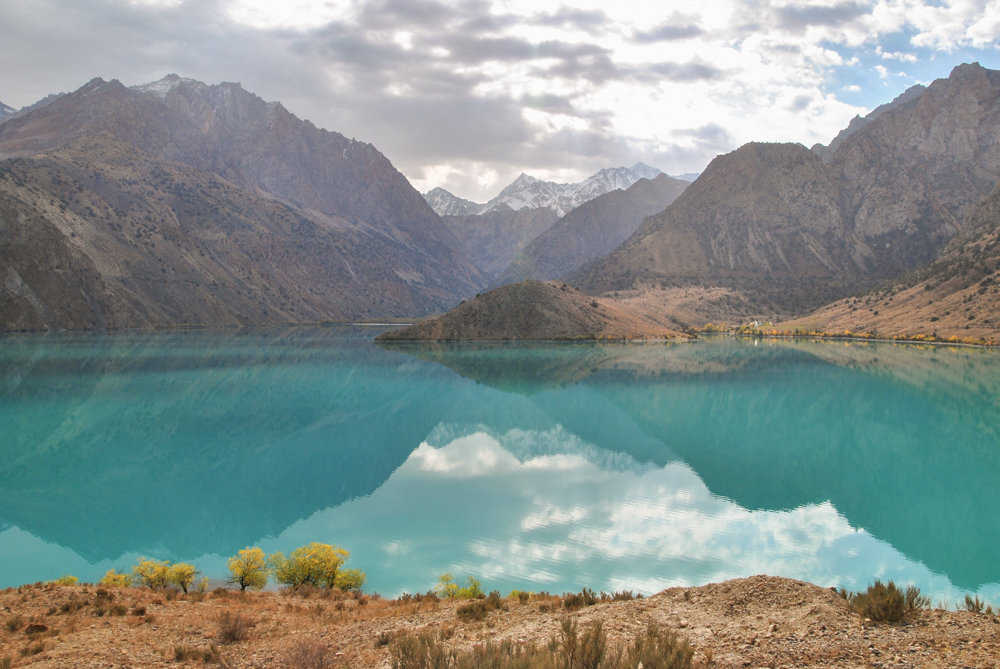
After 4 hours of steep and winding uphill climbing, we reached the peak. There lying in the cradle of the Fann Mountains, lovingly called “the emerald framed by grey-haired mountain tops” by residents was the Iskanderkul Lake – Sitting between spurs of Hissar range, 72 m deep at its deepest, it lies at an altitude of 2,255m above sea level.
What stunned me was the colour. The deep cerulean colour of the water spectacularly contrasts with the red-brown of the rock’s faces. Seeing it from a vast distance, I understand now why they call it the real pearl of the Pamir-Alay.
The next day, as we were driving out of the lake, we stopped to take some close up shots of the lake. Once again, I headed towards the shorelines but stopped slightly further.
I looked at the enormous rocky masses, which surrounded it. The shore dotted with a narrow strip of willow, barberry, sweet briar and sea buckthorn shrubs. The same familiar “fear of the unknown” feeling hit me again. This time I did not touch the water.
As I turned my back and headed towards the jeep, my heart felt heavy. Like I left something behind. An ache replaced anxiousness.

And that’s when I realised; it was the wilderness which Vadim proudly called his mountains! It was my fear of Tajikistan’s uncultivated remoteness. The rugged landscape was intimidating and unapologetically flaunting its overwhelming beaut, raw and beautiful to the point it was scarcely believedle.
Even now as I write this and look back at the photos, those same emotions stir me. Yuri Vizbor, a Russian bard, famously wrote a line in his song which said, “I’ve left my heart in Fann Mountains, now go on plain heartless…” The same is true for me.
Text and photos by
Thulasi Mahadevan



